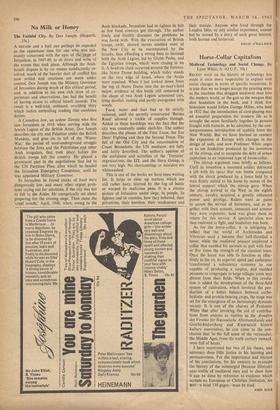Horse-Collar Capitalism
RECENT work on the history of technology has made it once more respectable to explain vast social changes in terms of specific inventions. It is true that we no longer accept the printing press as the machine that dragged mediteval man into the modern world, or the gun as the weapon that shot feudalism in the back, and I think few historians would follow George Miller, who held in 1832 that the introduction of card-playing was an essential preparation for modern life as it brought the sexes familiarly together (a process fraught with hazards, as he admitted, by the con- temporaneous introduction of syphilis from the New World). But we have learned to connect the expansion of Europe with changes iii the design of sails, and now Professor White urges us to see feudalism produced by the invention of the stirrup, and to recognise the debt of urban capitalism to an improved type of horse-collar. The stirrup argument runs briefly as follows. mounted soldier Until its invention a delivered a jab with his spear that was feeble compared with the shock produced by a lance held by a man firmly united to his horse by means of the lateral support which the stirrup gave. When the stirrup arrived in the West in the eighth century, cavalry acquired a greatly enhanced power and prestige. Rulers were at pains to secure the service of horsemen, and as to- gether with their mounts, remounts and armour they were expensive, land was given them in return for this service. A specialist class was thus endowed to fight, and feudalism was born. As for the horse-collar, it is intriguing to reflect that the world of Archimedes and Vitruvius used a harness that half-throttled a horse, while the medimval peasant employed a collar that enabled his animals to pull with four or five times the strength of the classical team. Once the horse was able to function as effec- tively as the ox, its superior speed and endurance transformed a subsistence economy to one capable of producing a surplus, and enabled peasants to congregate in large villages some way distant from their fields. When to this revolu- tion is added the development of the three-field system of cultivation, which involved the pro- duction of a better balance between carbo- hydrate- and protein-bearing crops, the stage was set for the emergence of an increasingly dynamic society. It is one of the charms of Professor White that after invoking the aid of contribu- tions from sources as various as the Annalen des Vereins fiir Nassauische Altertumskunde und
h
Gescichtsforchung and K wartalnik historii kultury materialnej, he can come to the con- clusion that 'in the full sense of the vernacular, the Middle Ages, from the tenth century onward, were full of beans.' I have mentioned but two of his theses, and summary does little justice to his learning and persuasiveness. For the importance and interest of his conclusions, for his concern to re-create the history of the submerged (because illiterate) nine-tenths of medimval men and to show how it can be done by reference to evidence which accepts no European or Christian limitation, his text—a brief 130 pages—must be read.
JOHN HALE


































 Previous page
Previous page